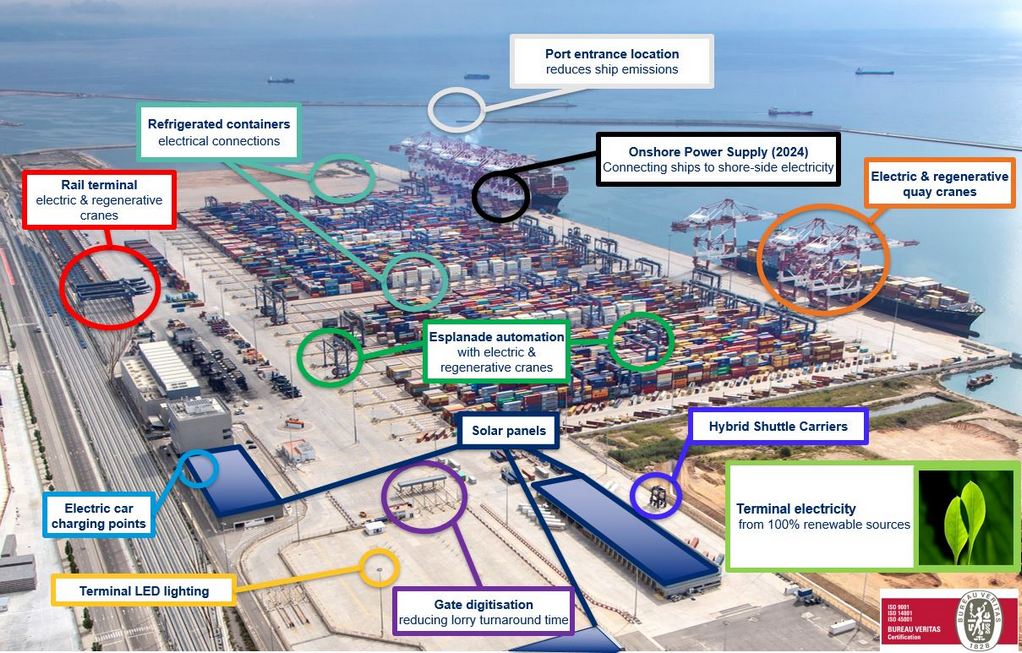The Hutchison Ports BEST terminal in the Port of Barcelona is considered one of the greenest container terminals in the Mediterranean attributed to the design of its infrastructure and the way it conducts its operations. In addition, in 2022 it has eliminated scope 2 emissions by opting for electricity from 100% renewable energy.
Guillermo Belcastro, CEO of Hutchison Ports BEST says: “BEST is taking a leadership role in assisting supply chains in becoming more sustainable. Consumers are demanding ever more sustainable products and that means that logistics players must address those needs accordingly”.
As a member of the Hutchison Ports group, BEST is taking a lead in the fight against climate change. It has been operating efficiently for more than 10 years and has managed to reduce 65% of carbon emissions compared to a conventional terminal; this is due to the fact that the terminal is semi-automated and uses mostly rail-mounted electric cranes.
At BEST, emissions are reduced both at quayside for ships and at the gates for trucks. The overall efficiency also allows shipping lines to minimize their port turnaround time and speed before arriving at the port of Barcelona and upon completion of its operations.
Mr Belcastro also stated: “the future of sustainability is already here; by reducing its emission by 57% (following GHG protocol) BEST is almost 10 years ahead of the targets established by the European Union and the International Maritime Organization of 55% and 40% in 2030 respectively”.
BEST is undertaking an energy self-sufficiency project since December last year. It has installed 1,832 solar panels on close to half a hectare of roofs of its buildings, capable of generating 1.18 GWh of electricity, equivalent to the annual electricity consumption of about 200 homes.
In collaboration with the Barcelona Port Authority, BEST is scheduled to provide shore power in 2024. This project, which is being carried out by the Port Authority, will allow ships to connect to electricity with a guarantee of 100% renewable sources and save emissions during their stay in the port. It is also expected that the current expansion of the terminal’s storage area will allow 100% of refrigerated containers to be connected to electricity from renewable sources by the end of 2024.
Finally, the group is committed to using rail transport, which considerably reduces atmospheric emissions by removing lorries off the road. In the last 10 years, BEST has been key in increasing local rail traffic share at the Port of Barcelona from 3% to 20%. This is thanks to BEST’s own rail terminal, investment in inland intermodal terminals in northern Spain (in Zaragoza, Noain, Villafría, Agoncillo and Miranda de Ebro) and the creation of the rail operator, Synergy, which helps to expand the Port of Barcelona’s area of influence.
BEST was inaugurated 10 years ago and is a benchmark in terms of sustainability within the terminals of the Hutchison Ports group, which operates 52 terminals in 25 countries.
Hutchison Ports has committed to setting both near-term and net-zero targets in line with the Science Based Targets initiative’s (SBTi) net-zero standard. The group will set ambitious emission reduction targets in line with this and reach net-zero GHG emissions by 2050.
Source: Hutchison Ports BEST
Tags: Emission Reduction, Europe, Hutchison Ports BEST, IMO, Renewable Energy, Scope 2



Recent Posts
Sea cruise ships can now connect to shore power in Amsterdam
Corvus Energy partners with HD Hyundai Mipo for AiP on new green product tanker design.
KR and HD Hyundai Heavy Industries Team Up to Develop a Very Large Ethane Carrier
HD Hyundai Leads Maritime Decarbonization at Nor-Shipping 2025
World’s Largest Green Hydrogen Plant Reaches 80% Construction Completion Across All Sites
Wärtsilä to Power USA’s First All-Electric High-Speed Ferries in San Francisco Bay
ABS and Pusan National University Chart a Course for Liquid Hydrogen Shipping
RIC Energy and Siemens Partner to Advance Green Hydrogen and E-Fuels Projects in Spain